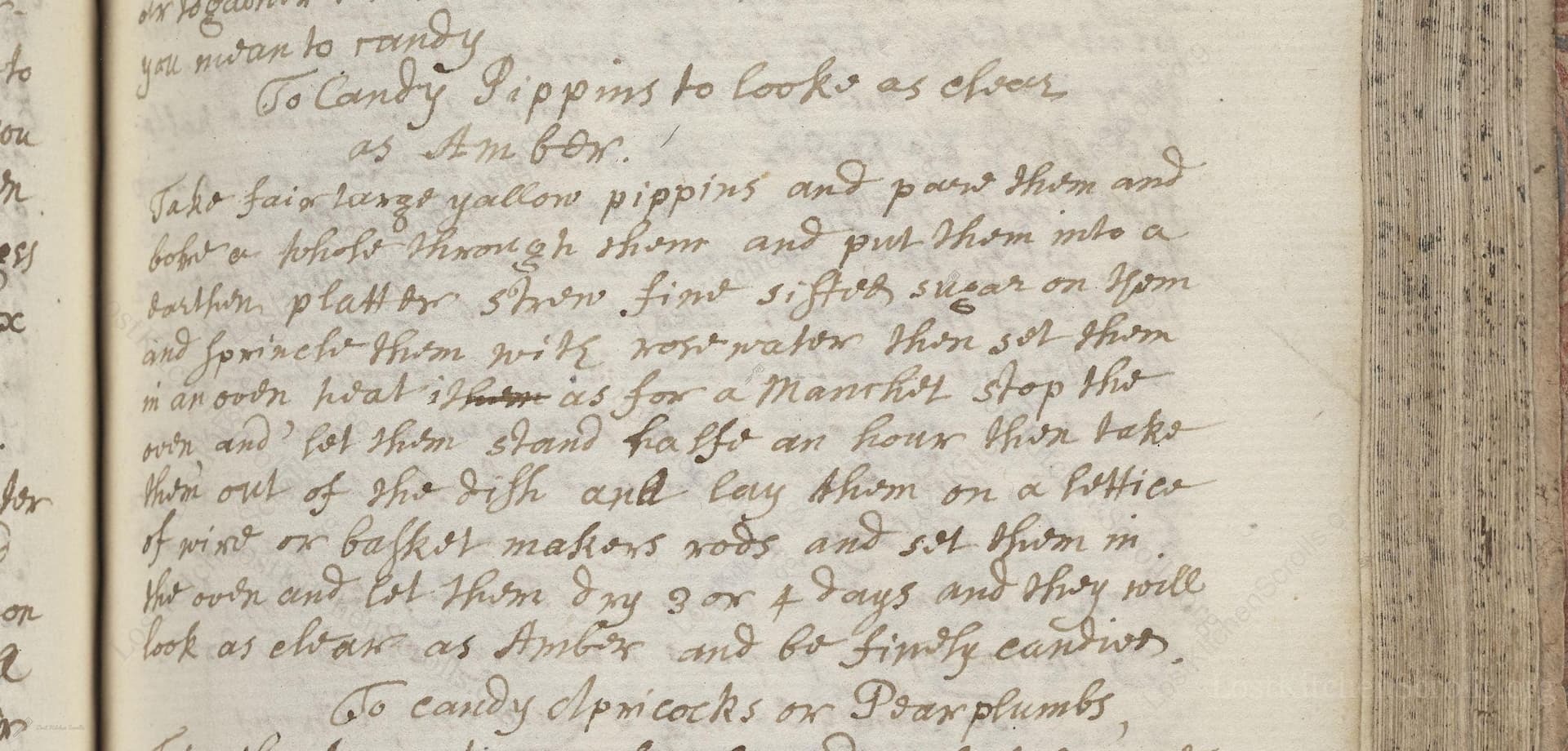To Candy Pippins To Looke As Cleare As Amber
From the treasured pages of Manuscript cookery book
Unknown Author

To Candy Pippins To Looke As Cleare As Amber
"Take fair large yallow pippins and put a bodkin through them and put them into a earthen platter. then strew fine sifted sugar on them and sprinkle them with rosewater then set them in an oven heat it warme as for a Manchet, stop the oven and let them stand half an hour then take them out of the dish and lay them on a lattise of wyre or bakers mackons nods and set them in the oven and let them dry 3 or 4 days and they will look as cleare as Amber and be finly candide."
Note on the Original Text
The recipe is instructional rather than prescriptive; it assumes a considerable degree of prior knowledge about kitchen operations, oven management, and ingredients. The language is delightfully economical, often omitting quantities, cooking times, and explicit temperatures—common in recipes before the widespread use of standardized measurements and thermometers. Spelling reflects the fluidity of early Modern English ('yallow' for yellow, 'makons nods' for bakers' lattice or racks). Terms like 'manchet' refer to a fine white bread, indicating the desired oven temperature, and 'candy' is used as a verb, meaning to turn fruit into a glossy, preserved sweet.

Title
Manuscript cookery book (1680)
You can also click the book image above to peruse the original tome
Writer
Unknown
Era
1680
Publisher
Unknown
Background
A tantalizing window into the kitchens of yesteryear, this late-17th century collection presents recipes and culinary wisdom meant to delight and surprise even the most discerning of historical gourmands.
Kindly made available by
Folger Shakespeare Library
This recipe hails from the late 17th century, a period characterized by newfound fascination with sugar work and elegant sweetmeats among the English gentry. Preserving and candying fruit was at the height of fashion in upper-class households, both as a means of displaying wealth—sugar was a luxury—and as an outlet for aesthetic culinary creativity. The recipe is taken from 'V.a.630', a manuscript dating from between 1675 and 1686, likely compiled by or for a household keen on keeping up with contemporary culinary trends. Such manuscripts often included a mix of practical and sophisticated recipes, reflecting the era’s growing interest in both preservation and presentation.

In the 17th century, cooks making this recipe would have used an earthenware platter for the first baking stage and a bodkin (a slender, pointed tool) to pierce the fruit. An open-hearth or small brick oven, maintained at a steady, gentle heat, would serve as the heat source, while a wire lattice or racks (sometimes fashioned by bakers as 'nods') would be employed to support the fruit for drying. Sugar was sifted by hand with fine sieves, and rosewater was a staple flavoring distilled or purchased by affluent households.
Prep Time
10 mins
Cook Time
30 mins
Servings
4
We've done our best to adapt this historical recipe for modern kitchens, but some details may still need refinement. We warmly welcome feedback from fellow cooks and culinary historians — your insights support the entire community!
Ingredients
- 4 large yellow apples (such as Golden Delicious or Cox’s Orange Pippin, approximately 9 oz each)
- 8 tablespoons (3.5 oz) superfine (caster) sugar
- 4 teaspoons (0.7 fl oz) rosewater
Instructions
- To recreate 'To Candy Pippins to look as cleare as Amber' for the modern kitchen, begin by selecting large, firm, yellow apples—Golden Delicious or Cox’s Orange Pippin are ideal modern varieties.
- Pierce each apple through the center with a thin skewer or similar tool and place them in an oven-safe dish.
- Sprinkle each apple liberally with about 1-2 tablespoons of superfine (caster) sugar, then lightly moisten them by sprinkling with a few teaspoons of rosewater.
- Heat your oven to approximately 325°F (conventional) or 285°F (fan), similar to the gentle warmth used for baking a soft white bread.
- Place the apples in the oven and bake gently for 30 minutes, allowing the sugar and rosewater to begin to infuse and turn syrupy.
- Remove the apples and arrange them on a baking rack set over a tray.
- Return them to the warm (turned off or barely-on) oven, and over the course of 3-4 days, allow them to dry slowly until they become translucent and glossy, with a candied shine reminiscent of amber.
Estimated Calories
170 per serving
Cooking Estimates
It takes about 10 minutes to prepare the apples and arrange them in the dish. The apples bake for 30 minutes, then dry in a warm oven for 3-4 days. Each apple is one serving and contains about 170 calories.
As noted above, we have made our best effort to translate and adapt this historical recipe for modern kitchens, taking into account ingredients nowadays, cooking techniques, measurements, and so on. However, historical recipes often contain assumptions that require interpretation.
We'd love for anyone to help improve these adaptations. Community contributions are highly welcome. If you have suggestions, corrections, or cooking tips based on your experience with this recipe, please share them below.
Join the Discussion
Rate This Recipe
Dietary Preference
Main Ingredients

Den Bockfisch In Einer Fleisch Suppen Zu Kochen
This recipe hails from a German manuscript cookbook compiled in 1696, a time whe...

Die Grieß Nudlen Zumachen
This recipe comes from a rather mysterious manuscript cookbook, penned anonymous...

Ein Boudain
This recipe comes from an anonymous German-language manuscript cookbook from 169...

Ein Gesaltzen Citroni
This recipe, dating from 1696, comes from an extensive anonymous German cookbook...
Browse our complete collection of time-honored recipes



